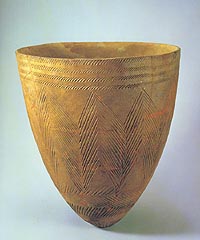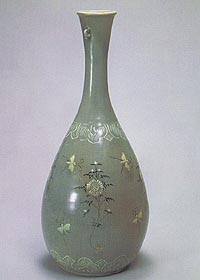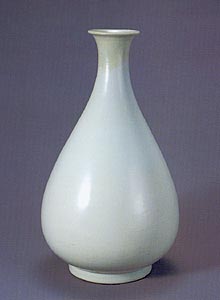The Age of Celadon
The age of clayware and earthenware
China's early ceramic history is best documented
by its Neolithic-era red ware which
was created out of red clay along the Yellow River. They later developed a shiny
black pottery, a two-colored ware with green and brown glazes and finally
three-colored ware in the late 7th century.
Combed earthenware is some of the earliest Korean pottery but
was replaced by a stronger plain earthenware during the Bronze Age. During the
2nd and 3rd centuries B.C. new techniques were introduced that allowed the
Koreans to produce grayish-blue stoneware which was common during the
Three
Kingdoms period (Shilla, Paekche, Koguryo). Ash ware and lead-glazed wares also were briefly produced in Korea but
were soon replaced by the introduction of celadon from China.
Japan's earliest pottery, Jomon earthenware, is believed
to have been made as early as 12,000 years ago. It was followed by
Yayoi earthenware and the red Haji
ware of the Kofun period. Japan also produced Sue ware which was used primarily
as storage vessels, up through the 11th century.
The cultures of the Southeast Asian region influenced each
other greatly due to their proximity and Vietnam especially, seemed to inherit a
number of ceramic traditions from its neighbor, China. Gray ware similar to that
produced by the Chinese Han dynasty, was made in Vietnam at the same time
it was produced in China, and by the 6th century Vietnam was producing a celadon-like type
of ash-glazed ware of their own. By the 10th century they had developed their own unique
style of ceramics which included a rough celadon, that was based on the the earlier
influences of China. Thailand also produced a number of different styles of
earthenware and eventually adopted the production of celadon from China.
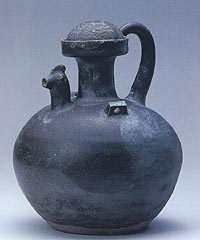 |
|
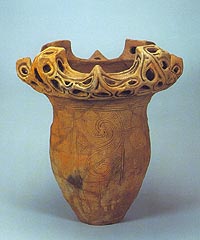 |
Jar with Chicken Head
|
Jar with Pointed Bottom
|
Jar
|
The age of celadon
Since the invention of ceramics by man in the Neolithic Age, and for the last
8000 years, man strove to develop the art of ceramic production and thereby
create stronger, more useful forms that possessed aesthetic beauty. During the
7th century celadon
appeared in China and dominated the world of ceramics for
the next 700 years. Celadon first appeared in various parts of
China in the form of early celadon-like ceramics, that often used ash glazes, and was finally put into large
scale production for utensils and pottery during the 7th Century throughout
China.
During the 9th Century, its production then spread to Korea, who had been
importing the Chinese celadon and, at first, emulated both the techniques and
styles the Chinese had used, and later developed styles and techniques of their
own. The quality of the Korean celadon, according to many experts, both Korean
and Chinese, came to surpass that of even the Chinese celadon that it was
derived from.
Japan didn't experience a celadon culture, but relied on
imported Chinese and Korean products. They did however, produce several types of
earthenware and ash-glazed ware which were used for everyday utensils.
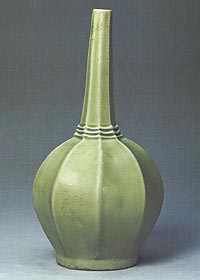 |
|
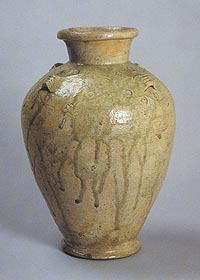 |
Octagonal Bottle
|
Bottle
|
Jar with Four Handles
|
Vietnam, who had been under Chinese rule, was the third country to adopt,
and begin the production of celadon wares during the 13th Century, though their
celadon did not possess the rich green colors of the Chinese or Korean products.
Thailand also produced celadon with beautiful green tones of which the fine
examples can be found from the 15th Century.
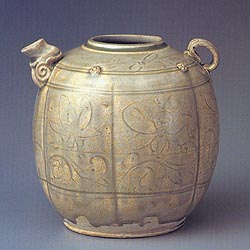 |
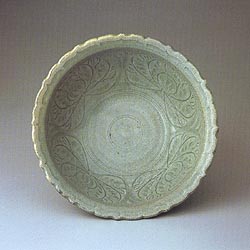 |
Ewer
|
Plate
|
The age of white porcelain
White porcelain required a more highly
advanced technique to make than celadon but was both stronger and therefore,
more practical for everyday use. High quality white porcelain, very much like
that we still use today, was invented in the Jingdezhen kiln in China and began to
replace celadon as the dominant ceramic in the middle of the 14th century. China
enjoyed a monopoly on the production of white porcelain for some time and
exported their high quality wares throughout Asia. They later used the brilliant
white background on the wares as the perfect backdrop for designs of brilliant
blue patterns that are still popular on Chinese ceramics today. Korea quickly adopted
the Chinese techniques and were producing their own white porcelain by the end
of the 14th century.
The Korean white porcelain differed in design from the
Chinese wares in that the elaborate decoration techniques used by the Chinese
were never practiced, and the resulting wares had a simpler, more elegant
look. The quality of Korean white porcelain advanced quickly after its
introduction and was soon of a high enough quality that it was sent as
a gift to the Ming Imperial Household in 1425.
Japan, using Korean artisans captured during the Japanese
invasions, created a kiln in the latter half of the 16th century and began to
produce white porcelain of their own. In the 1660's, through trade with the
Dutch East India Company, they exported their Kakiemon style of white porcelain throughout
Europe where it was highly esteemed.
Influenced by their close proximity to China,
Vietnam also began to produce white porcelain, actually quite
some time before Japan, in the middle of the 15th century.
Thailand also produced a white ceramic ware that was
decorated with a a brown glaze and was exported throughout Asia.
Europe, specifically Meissen, Germany, began to produce white
porcelain for the first time in the early 18th century.
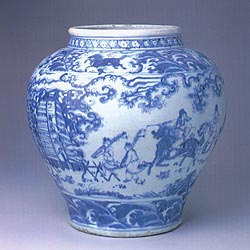 |
|
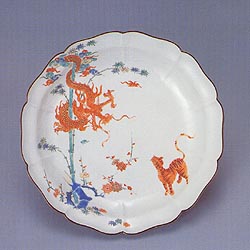 |
Jar
|
Bottle
|
Foliated Plate
|
